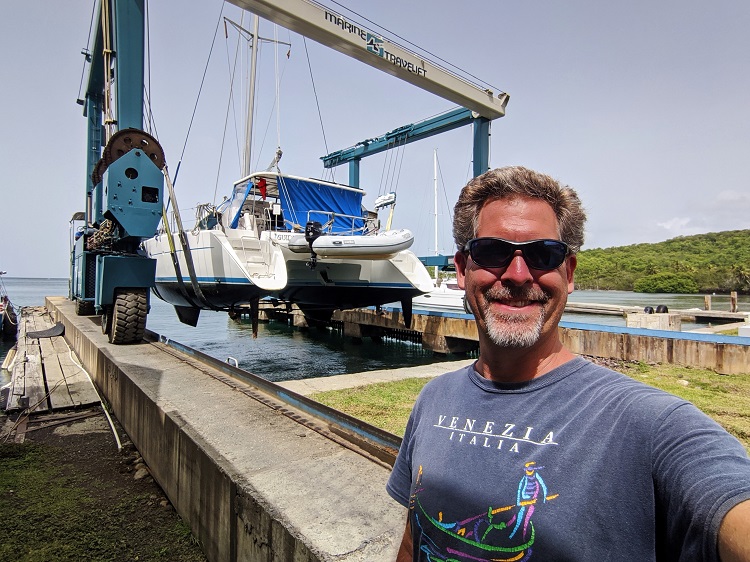
Now that I have the boat hauled out of the water, put away, and the yard working on it I had to figure out how I was going to get off the island of Grenada and back to The States since I can’t travel this off season due to Covid-19. I thought commercial flights were going to start back up July 1st, but that date came and went without any planes. So option two was to join 6-7 other sailors that chartered a private plane to St Thomas. It was not cheap, but it got me to where I could pick up a flight to the mainland. Since I still know several people on St Thomas I stayed for two nights visiting everyone and it was great.
My next move was to fly to Miami and spend several days with a couple of my guests that have been down to the boat four different times. We had a wonderful time hanging out, relaxing, going out to eat, and celebrating my birthday. But the coolest place they took me was the only surviving House of Refuge, which were designated as havens for shipwrecked sailors and travelers along the sparsely populated Atlantic coastline of Florida.
 The historic structure has weathered many storms and provided needed shelter for shipwreck survivors, including those of the Georges Valentine, an Italian brigantine whose wreckage remains just 100 yards off the rocky shoreline, providing an ideal dive site.
The historic structure has weathered many storms and provided needed shelter for shipwreck survivors, including those of the Georges Valentine, an Italian brigantine whose wreckage remains just 100 yards off the rocky shoreline, providing an ideal dive site.
The history of the House of Refuge dates to 1876, when the U.S. Life-Saving Service, under the direction of Sumner Kimball, constructed ten “houses of refuge,” or life-saving stations, along Florida’s Atlantic Coast.
 These houses were staffed by “keepers,” who, with their families, led solitary lives in order to find, rescue, and minister to those who fell victim to Florida’s treacherous reefs and shoals. Prior to construction of these houses, many shipwreck victims made it to the isolated shore and then perished of starvation and thirst. As part of their duties, the keeper and his family walked along the shores as far as possible in search of shipwreck victims.
These houses were staffed by “keepers,” who, with their families, led solitary lives in order to find, rescue, and minister to those who fell victim to Florida’s treacherous reefs and shoals. Prior to construction of these houses, many shipwreck victims made it to the isolated shore and then perished of starvation and thirst. As part of their duties, the keeper and his family walked along the shores as far as possible in search of shipwreck victims.
In 1915 the U.S. Life-Saving Service merged with the U.S. Revenue Cutter Service to form the U.S. Coast Guard, and then the House of Refuge became U.S. Coast Guard Station #207. The keeper at the time, Axel Johansen, and his wife, Kate, remained on duty, but Alex’s title was changed from Keeper to Surfman #1. Four other men were stationed at the house, and during World War I this crew of five was augmented by the Home Guard, composed of area youths.
 In 1942, when German U-Boats torpedoed freighters along the Treasure Coast, a lookout tower and additional buildings were constructed on the property. In 1945 the U.S. government decommissioned House of Refuge operations, and the house sat empty until 1953, when Martin County purchased it and its 16-acre grounds for $168.
In 1942, when German U-Boats torpedoed freighters along the Treasure Coast, a lookout tower and additional buildings were constructed on the property. In 1945 the U.S. government decommissioned House of Refuge operations, and the house sat empty until 1953, when Martin County purchased it and its 16-acre grounds for $168.
In 1955 the Martin County Historical Society was formed to protect the house and present it as a museum. Almost immediately, in addition to serving as a museum, the House of Refuge became a refuge for sea turtles, with this program being under the direction of Ross Witham (1917–2004), Marine Turtle Coordinator for the Florida Department of Natural Resources from 1963 to 1987. Now sea turtles, rather than shipwreck victims, depend on the life-saving measures of the House of Refuge.
 Today the House of Refuge is itself a survivor; it is the only one of the original ten houses of refuge to remain on the Florida Coast. Today it tells the story of the region’s significant maritime heritage and the Floridians who endured hardships for the sake of humanitarian service.
Today the House of Refuge is itself a survivor; it is the only one of the original ten houses of refuge to remain on the Florida Coast. Today it tells the story of the region’s significant maritime heritage and the Floridians who endured hardships for the sake of humanitarian service.
Not only were we able to see mid century buildings, clothing, furniture, and equipment, but Luara Kay’s father has many of his art work permanently hanging in the museum. This one was my favorite of the 5-7 paintings there. Of course he did over 500 painting in his life and that was only after he retired from starting and running a boat yard and being a pioneer in the sport fishing tourism business. He truly was an amazing man and it was great to see his works.


That is a great idea. Thanks.
Shane
Shane ,
A very well written / interesting article. You should reach out to your magazine contacts to see if they would like to pay you to publish it!
Looking forward to your visit to Colorado.
Michael